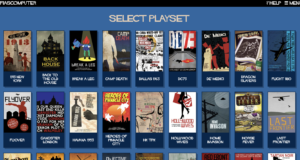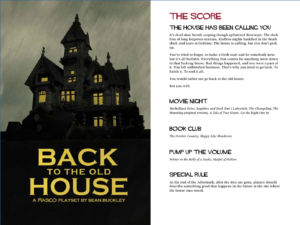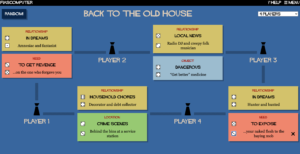Game Description + Theme
FiascoI is a GM-less role-playing and storytelling game in which 3-5 players tell the story of characters based on the role description. The characters are intended to have positive and negative outcomes, mostly negative to make the game interesting. The theme of this game is story-telling.
Mechanics

Players first set up the game by selecting a playset, assigning each player a role, establishing the relationship between each character, and defining the objects, locations, or needs between pairs.

The game consists of two acts and a tilt. In the first act, players take turns choosing to either establish the scene or resolve the scene. In establishing, they set the scene as they wish, and the other players must choose either a good or bad resolution to it. If the player chooses to resolve, the other players must establish the scene for the player to resolve.
At the end of act one, a tilt is introduced. Players are selected via a dice roll to determine the tilt from a deck of options. This tilt sets the ground rules for the remaining act. After the tilt has been established, act two proceeds just as act one. The game ends with each character having a positive or negative outcome.

Fun
Fiasco’s mechanics work together to create a dynamic that allows the user to experience the aesthetics of the game. More precisely, fun is achieved through Fantasy, Fellowship, and Expression aesthetics. The role-playing and story-telling theme of the game fosters a fantasy world in which players can bring to life any story being. It enables players to build an imaginary world defined but not limited by the characters, locations, objects, and needs that have been established.
Additionally, players experience fun via the Fellowship this game affords them. The act of working together to establish or resolve a scene encourages cooperation amongst the player. More importantly, the premise of the Fiasco as a story-telling game depends on characters working together to create a world together.
Another form of fun is Expression. As an RPG, Fiasco allows players to express themselves through their characters and the story/plot they choose to lead with. This, along with the ability to establish or resolve scenes as one desires, opens up room for gamers to express themselves as they wish, creating yet another form of fun that can be achieved by playing the game.
Abuse
One potential area of abuse in Fiasco stems from establishing or resolving scenes. Players might be biased towards certain players, allowing them to set up scenes or resolve scenes in favor of themselves and those they’re closer to. This can create a weird and unhealthy game dynamic since the story would be one-sided. One form of the designers has included in the “Let’s Not!” card. Players can tap this card to indicate that they don’t wish to resume with the proposed scenario.
Design & Business Model
The online design of this original board/card game is designed very well. Upon entering the site, it leads you through the set-up scene and explains the different steps of the game. The online format is designed to replicate the look and feel of the real-life game without the hassle that may come with the real-life version.
In both the online and the real-life version, you have to purchase the game in order to enjoy the full game. Unlike the physical setup where you have to buy the full set in order to try it out, the online format allows users to get up to act one for free before requiring players to purchase the game to proceed. This is a strategic business move as you’ve already caught the user’s attention and they’re more likely to invest in the game. Both options seem reasonable business models for Fiasco.
Insights
After playing this game with friends, I realized that it can get boring or hard to keep it going for long. The tilt addresses this concern but I would have liked more twists throughout the game to keep it engaging and guide us in our story development. Otherwise, this game was enjoyable to play!
For project 1, my group plans to adopt fellowship and fantasy aesthetics. Since our game has both individual and group goals, it will encourage both collaborations as well as competition.



